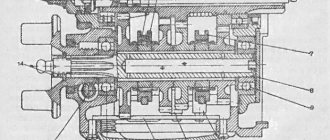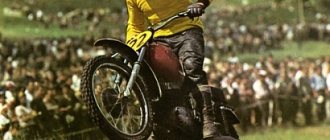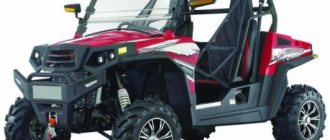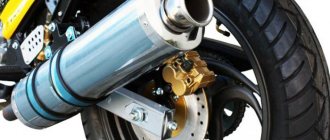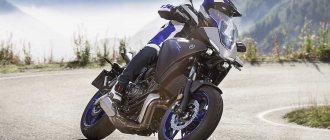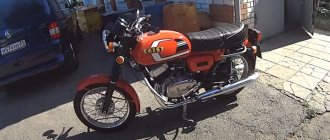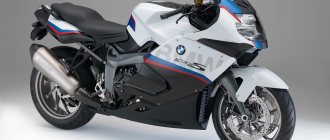| Motorradwerk Zschopau | |
| Type | Public company |
| Base | 1906 |
| Abolished | 2008 |
| Successor | MuZ Vertriebs GmbH |
| Former names | Zschopauer Maschinenfabrik JS Rasmussen |
| Founders | Jørgen Skafte Rasmussen |
| Location | Czopau, Germany |
| Industry | Mechanical engineering |
| Products | motorcycles |
| Website | muz.de |
| Media files on Wikimedia Commons | |
Motorradwerk Zschopau
(Russian: Motorcycle Plant Tschopau) is a motorcycle manufacturing plant in the city of Tschopau (Germany).
History of the enterprise[ | ]
Production of motorcycles under the DKW brand by Zschopauer Maschinenfabrik JS Rasmussen
At the machine-building plant in Czopau, acquired in 1906, it began in 1922. After World War II, the enterprise ended up on the territory of the GDR. Part of the equipment from the enterprise was exported as reparations to Izhevsk, where it was used to develop the production of the Izh-350 motorcycle - a copy of the DKW NZ-350.
In 1950, the nationalized enterprise, which became part of the association of vehicle manufacturers in the GDR (IFA), restored the production of motorcycles of the pre-war RT 125 model. In 1952, the enterprise was renamed VEB Motorradwerk Zschopau
and in 1956 began producing motorcycles under the MZ brand[1][2].
The company mass-produced motorcycles with engine capacity from 125 to 350 cm3. MZ motorcycles were distinguished by their simplicity of design, high reliability and were in demand not only in the countries of the socialist camp, but also in Western Europe. They were supplied to about 100 different countries[2]. In limited quantities (the largest batch of 700 units was purchased in 1957, subsequent deliveries usually did not exceed 100 units per year) MZ motorcycles (mainly sports) were imported to the USSR[3]. A certain number of MZ motorcycles were imported into the USSR by citizens who worked in the GDR, for example, officers of the Western Group of Forces. The number of employees at the enterprise reached 3,000 people, and the annual production of motorcycles was 85,000 units[2]. In 1983, the two-millionth MZ motorcycle model ETZ 250[de] was produced.
MZ RE 250 season 1964
MZ motorcycles performed successfully in motorsports[1]. Motorradwerk Zschopau and played an important role in this.
engineer Walter Kaaden, who developed the original design of a two-stroke engine with disc valves at the inlet.
The company produced motorcycles for circuit racing with an engine capacity of 50, 125 and 250 cm3. In 1958, Horst Fügner won the Swedish Circuit Racing Grand Prix with an MZ RE 250. At the end of the year, Fugner became a bronze medalist. In 1959, Rhodesian Gary Hawking, riding MZ, became the season's silver medalist. In 1961, MZ team rider Ernst Degner defected to the West, transferring developments on MZ racing motorcycles to Japanese companies. For the 1963 season, Yamaha prepared the RD 56 motorcycle, very similar to the MZ RE 250. Soon the Suzuki team also acquired an MZ clone. Since the budget of the MZ sports team was 50 times less than that of Japanese companies, it began to suffer defeats. The situation was aggravated by NATO countries refusing to issue visas to athletes from the GDR. In this regard, VEB Motorradwerk Zschopau
decided not to participate in circuit racing in the early 70s and switched to enduro competitions, where it also achieved significant success. Team MZ won the Enduro World Championship in 1963, 1964, 1965, 1966, 1967, 1969 and 1987.
In 1991, the enterprise was privatized. From 1992 to 1999, the company's products were produced under the MuZ brand (from Motorrad und Zweiradwerk - manufacturer of motorcycles and other two-wheeled vehicles). In 1999, it returned to its former name MZ.
From 1996 to 2001, MZ motorcycles were produced under license in Turkey under the MZ Kanuni brand.
After the reunification of Germany, demand for the company's products began to fall. Since 1991, the plant has been unprofitable. The development of new models did not save the situation. In 1996, the company was bought by the Malaysian concern Hong Leong[en]. In September 2008, motorcycle production at the company ceased. On December 12, 2008, the plant was closed. In March 2009, the plant was bought by former motorcycle racers Ralf Waldmann and Martin Wimmer. Attempts to revive the MZ brand, the last of which was made in 2013, were unsuccessful[2]. The production of spare parts for MZ motorcycles remains at MuZ Vertriebs GmbH
.
MY MOTORCYCLE
Test drive motorcycle MZ
MZ - These two letters on a motorcycle tank were known to almost the whole world. This is the name of the people's enterprise of the GDR "Motorradwerk Zschopau", which is without a doubt one of the most famous motorcycle enterprises among the socialist countries.
The production of motorcycles in this Saxon town has a long tradition, which after the Second World War expanded so much that the town of Zschopau received the unofficial name “motorcycle town”. The first two-wheeled vehicle (a bicycle with a motor) was produced here back in 1921. This vehicle bore the DKW brand, which in subsequent years became famous for producing reliable motorcycles, and later cars with two-stroke engines. In the former workshops of this company, after the war, the national industry of the GDR resumed the production of motorcycles in 1950. The future production program of the enterprise was determined by the fact that since the war years, 1,686 pieces of DKW motorcycles of the pre-war model RT-125 remained in the workshops in a semi-assembled state.
It was a simple lightweight motorcycle with a 123 cm3 single-cylinder two-stroke engine. The motorcycle had enviable advantages. His weight did not exceed 66 kg. Fuel consumption was only 2.2 liters per 100 km. Subsequently, during the production process, this model was constantly modernized. So, already in 1953, the motorcycle had a front telescopic fork and telescopic shock absorbers in the rear wheel suspension (Photo 1). One of the best upgrades was the installation of a fully enclosed chain drive. An increase in engine power and other upgrades increased the weight of the model to 88 kg. This did not prevent the motorcycle from reaching 80 km/h, including with two riders (the pre-war model was single-seat).
At that time, motorcycles produced in Zschopau were called IFA, and only in the second half of the 50s, after the reorganization of automobile production, motorcycles began to be called MZ. After the “one hundred and twenty-five”, the production of motorcycles in the class above 175 cm3 and 250 cm3 was mastered. Their engines were the same - single-cylinder and two-stroke. In addition, the plant produced an interesting and unusual model “BK-350” (Photo 2). The model had an opposed two-stroke two-cylinder engine, the drive to the rear wheel was carried out by a cardan shaft. The motorcycle was intended for use with a sidecar, which at that time were very popular in the GDR due to the post-war shortage of passenger cars. The motorcycle, whose advantages included a low center of gravity, contributing to excellent handling, was not produced for long. Its production was soon discontinued and the “BK-350” model remained a curious moment in the history of MZ.
The MZ plant specialized in the production of single-cylinder two-stroke engines of a fairly orthodox design, but German precision and excellent workmanship allowed it to achieve remarkable performance in its class. So, back in 1970, the MZ-250 had a power of 14 kw and a speed of 130 km/h. Comfort was provided by the spring suspension of the engine in the frame, as well as the wheel suspension, equipped with long-stroke hydraulic shock absorbers with well-chosen springs. In the late 50s, the trend for front swing-arm forks came to Europe, and MZ happily followed it for a while (Photo 3). But by the end of the 60s he returned to the traditional telescopic fork.
When talking about this brand, one cannot help but talk about the company’s sporting successes. Having not yet completed the post-war renovation, they were already thinking about sports. In the first half of the 50s, a sports department was created. The company achieved its first sporting successes under the IFA brand. Czechoslovakian fans also know this, having witnessed the victory of their compatriot Petruschka in the 1952 Czechoslovak Grand Prix at the Brno circuit in an IFKA in the 125 cm3 class. The remarkable Czechoslovakian driver Frantisek Stastny, who won fifth place in the Swedish Grand Prix in 1961, could also talk about the speed qualities of the racing “two hundred and fifty”. MZ racing motorcycles with two-stroke water-cooled engines with a spool-type mixture were at their best in the sixties.
A single-cylinder “fifty” motorcycle with an eight-speed gearbox reached a speed of 140 km/h in 1962, and five years later a three-cylinder “one hundred and twenty-five” reached a speed of 185 km/h, while at the same time a two-cylinder “two hundred and fifty” developed 230 km/h. With such parameters, such world-famous racers as G. Hocking, D. Woodman, A. Shepherd, S. Grassetty did not hesitate to perform on the “Mtseta”, and the signature racer MZ H. Rosner, who in the 1966 World Championship, did not lag behind the famous foreigners took fifth place in the 250 cm3 class, behind two Hondas and two Yamahas. [ An amazing result for European and especially “socialist country” technology at that time. (translator's note)].
In total, MZ motorcycles won thirteen Grand Prix. In 1973, the company stopped participating in circuit racing - it was no longer possible to compete with the Japanese. The company switched to the production of enduro motorcycles and achieved serious success in the “six-day” cycle.
After the reunification of Germany, the company, naturally, ceased to be a national enterprise and changed its name. It began to be called MuZ and made powerful motorcycles in small quantities with foreign engines (Japanese or Austrian), but the success was only so-so. According to the latest information, they have come to their senses. They dropped the ridiculous letter U from the name and are going to return to independent production of modern engines, including two-stroke ones. Glad we finally came to the right decision. Only very narrow-minded people could refuse a popular brand with a rich sports history, even if two-stroke engines ceased to be popular.
I can’t help but talk about my personal impressions. In 1978 I served in Poland (former officer). By that time, I had experience riding on Java, on the “old lady” and on the then new model “634”, on Izha, on our heavy motorcycles and even on the Polish 150 - “WSK”. I am listing this to show that I had some experience. And so the MZ model “ETS 250 Trophy” fell into my hands for the whole day. The motorcycle impressed with the excellent quality of finishing, low seating, different wheels (front 16, rear 18), voluminous stylish tank, tachometer (our clumsy motorcycle industry has not yet learned how to make this necessary and simple device). I was surprised by the completely low noise of the engine and the almost complete absence of vibration. After riding it for a day, I just wanted to shout “Das ist Fantastish!” Insane throttle response, absolutely effortless acceleration, confident riding at a speed of 130 km/h (I didn’t take any more risks - the motorcycle was someone else’s), clear, effortless gear shifting, in short - complete delight. Years have passed, but no motorcycle has given me more pleasure, except perhaps the Suzuki 400, but the ease of riding still cannot be compared with the Mzet.
Test drive motorcycle MZ
List of models[ | ]
MZ TS 150 MZ ETZ 250 MuZ Skorpion Tour 660 (1995) MZ RT 125 (2000—2008)
- RT 125 series, 1950—1965 1950—1954 IFA RT 125
- 1954—1956 IFA RT 125/1
- 1956—1959 RT 125/2
- 1959—1962 125/3
- 1964—1965 125/4
- 1952—1956 IFA BK 350
- 1956—1957 ES250 Doppelport
- 1969—1973 ETS 250
- 1973—1976 TS 250
- 1981—1989 ETZ 250
Gallery[ | ]
- IFA BK 350
- MZ 125/3 (1959)
- MZ GS 250
- MZ ES 250
- MZ ES 250/2 (1967–1973)
- MZ TS 250/1 "Luxus" (1976–1981)
- MZ ETZ 250
- ETZ 125
- Skorpion Tour (1995)
- MZ SM 125 (2001–2008)
- MZ 1000 S (2003–2008)
- MZ 1000 SF (2005–2008)
Report on a visit to the GDR Motorcycle Museum in Berlin. MZ.
Hello.
In this post I collect MZ motorcycles from the GDR Motorcycle Museum and give a brief history of the company. The motorcycles themselves, unfortunately, for the most part have a simple, not very interesting design with a two-stroke engine and a minimum of bells and whistles. However, they were produced in hundreds of thousands of copies, so they occupy a significant place in the history of the motorcycle, at least due to their scale and prevalence.
The MZ motorcycle production plant (Motorradwerk Zschopau) was located in Germany, in the city of Cschopau. Until the end of World War II, this plant produced DKW motorcycles; after the war, the plant ended up on the territory of the GDR, controlled by the USSR. Some of the equipment was taken to Izhevsk, as a result of which we received an Izh motorcycle, almost completely copied from the DKW NZ-350, which then evolved into the Izh-49 and further down the list.
Since 1956, the plant began producing motorcycles under the MZ brand. These were two-stroke, technically simple and lightweight motorcycles, the production of which was designed for scale. It’s a big strange thing that MZ were imported into many countries of the world, while they were practically absent in the USSR. Of course, in the Soviet Union there were other manufacturers that saturated the market with motorcycles: domestic Urals, Dnepr, Izhi and Voskhody. There was also Czech Java and CZ. But why there was no place for MZ in this huge market is a mystery to me.
In 1983, the two millionth motorcycle was produced.
Continuing the theme of non-capitalist markets (pun intended


